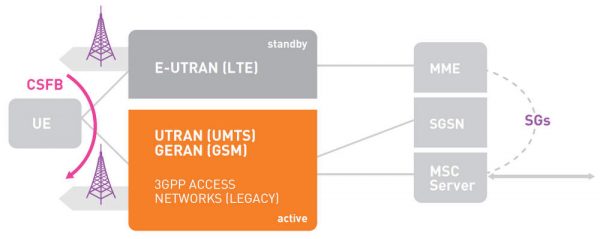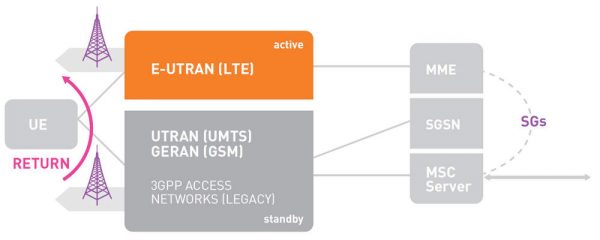LTE is an all-IP network with no CS support. To support voice communication operators have many options.
- Voice Over LTE
- Voice Over WiFi
- CS Fallback
Let’s check briefly about the above options for voice communication.
Voice Over LTE (VoLTE)
VoLTE is the true solution for voice communication over the all-IP LTE network. It uses the IMS (IP Multimedia Subsystem) to initiate, connect and terminate voice communication.
The service is heavily dependent on many new core network elements.
I wrote a complete beginners guide on VoLTE which you can find here.
Voice Over WiFi – VoWiFi
Some operators use VoWiFi to offload voice traffic over a WiFi network. Though VoWiFis is the commercial name, the service is sometime referred as EPDG, WiFi Offload, etc.
Similar to VoLTE, VOWiFi uses the IMS to initiate, connect and control voice communications.
Some operators support all the above options and some support only CS Fallback (CSFB). The basic reason behind this is the cost to implement VoLTE and IMS.
In this tutorial we will check simple CSFB signalling call flows. We will check cases for both MO (Mobile Originated) and MT (Mobile Terminated) calls.
CS Fallback (CSFB)

When LTE was introduced there was practically no option for voice communication. VoLTE was on development phase and was not actively rolled out. To support voice and other CS services CS Fallback was introduced.
Simply speaking, when a UE or mobile phone starts a voice call the network move the UE to a legacy UMTS (3G) or GSM (2G) network. The UE use the legacy network to initiate the call and complete the call. After the call is over UE again move back to the LTE network.

When in legacy network (3G/2G) the UE can have PS data sessions. PS data is supported in 2G network only when DTM (Dual Transfer Mode) is supported. When UE supports DTM it can have both voice and data simultaneously.
NOTE: The network must support the SGs interface to support CS Fallback.
The big advantage CSFB is that in the initial phase operators did not need to roll out IMS VoLTE.
LTE MO CS Fallback Call Flow
The precondition is the UE is registered to the LTE network. We do not have any VoLTE service available. So when the UE will originate the call, the network will ask the UE to move to 3G to initiate the call.
+-----------+ +------------+ +-------------+
| UE | | EUTRAN | | UTRAN |
+-----------+ +------------+ +-------------+
+-----------------------------------------------------------+
| | UE is in EUTRAN IDLE state | |
+-------------------------------+---------------------------+
| | |
| | |
MO Call Initiated | |
| | |
| | |
LTE Idle to Active transition Including Extended Service Request
| | |
| RRCConnectionRelease | |
| (RedirectedCarrierInfo) | |
+<-------------------------- | |
| | |
Tune to UTRAN, Acquisition | |
| | |
| System Information (MIB) |
| <--------------------------+------------------------+
| | |
| System Information (SIB1/3/5/7)
| <--------------------------+------------------------+
| | |
| System Information (SIB11/12/19) |
| <--------------------------+------------------------+
| | |
| | |
| RRC connection setup |
| | |
| | |
| NAS end-to|end CS call setup |
| | |
| | |
| | |
Let’s discuss what happens for the MO call.
Initially UE is registered on EUTRAN network and is idle state. This is the precondition.
When UE starts the call it goes from idle to active state. The eNodeB now redirect the UE to a legacy network.
This is done through the RRC Connection Release message. This message contains the IE RedirectedCarrierInfo. It also has the details about the target UARFCN(WCDMA) or ARFCN(GSM).
When UE receives this message it tune into the target network. In our example the target network is UTRAN.
In the target network the UE reads the MIB (Master Information Block) and other required System Information Blocks. You can know more about UMTS MIBs and SIBs here.
The next step is to start the RRC connection procedure to initiate the voice call in UTRAN network.
LTE MT CS Fallback Call Flow
In case of MT call, our UE is registered and is in LTE network. It receives a CS service notification EPS mobility management message for an incoming call. The LTE network will redirect the UE to UMTS network to complete the call.
CS Service Notification message: This message is sent by the network when a paging request with CS call indicator was received via SGs for a UE, and a NAS signalling connection is already established for the UE.
For more information about CS Service Notification message check 3GPP 24.301 specification.
In response to this the UE sends the Extend Service Request message. In this message it mention the service type as “mobile terminating CS fallback”.
Also, it sets that the CSFB request is accepted by the UE.
After receiving this message, the UE prepares itself for CSFB procedure. It starts the timer T3417.
The network then sends the RRC connection release message with redirectedCarrierInfo.
The UE does a IRAT Redirection. After moving to WCDMA it reads the MIB and necessary SIBs.
Then it triggers the RRC Connection Request with cause terminatingConversationalCall.
+-----------+ +------------+ +-------------+
| UE | | EUTRAN | | UTRAN |
+-----------+ +------------+ +-------------+
+-----------------------------------------------------------+
| | UE is in E|UTRAN IDLE state | |
+--+----------------------------+---------------------------+
| |
MT call|Received | |
| |
CS Service Notification | |
| | |
LTE Idle to Active transition Including Extended Service Request
| | |
| RRCConnectionRelease | |
| (RedirectedCarrierInfo) | |
+<-------------------------- | |
| | |
Tune to UTRAN, Acquisition | |
| | |
| System Information (MIB) |
| <--------------------------+------------------------+
| | |
| System Information (SIB1/3/5/7)
| <--------------------------+------------------------+
| | |
| System Information (SIB11/12/19) |
| <--------------------------+------------------------+
| | |
| | |
| RRC connection setup |
| | |
| | |
| NAS end-to|end CS call setup |
| | |
| | |
| | |

Permalink
Does MO call take more time than MT call to establish? Is paging a reason. will need little information on this
Permalink
Hi
We facing an issue in MT calls during CSFB in paricular in one sector. What could be the reason.
Permalink
GOOD ONE
Permalink
Fantastic site. Plenty of helpful information here.
I’m sending it to some pals ans also sharing in delicious. And obviously, thank
you for your sweat!
Permalink
Assume-B party in LTE in idle state
Question-How paging is done to B party by MSC ..How MSC know the location of B party
Permalink
Good answer back in return of this question with real
arguments and describing everything on the topic of
that.